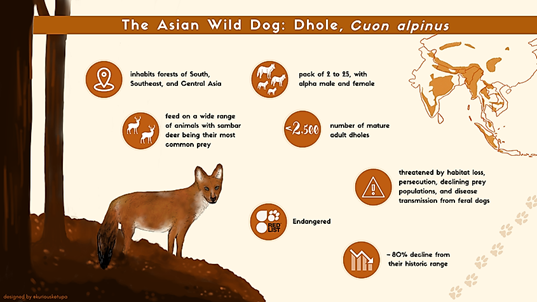

3rd September 2022 (6 Topics)
Context
As per studies, limited knowledge about the life history of endangered species is a common obstacle in addressing conservation challenges.
- One such enigmatic species under threat is the forest-dwelling, social canid of Indian forests — the dhole (Cuon alpinus).
About
About the species:
- Geographic Range: From the Altai Mountains in Manchuria in Central and Eastern Asia, its range spreads southwards through the forest tracts of India, Burma, and the Malayan Archipelago. Three races of the dhole exist in India alone.
- Habitat: Dholes like open spaces and can often be found on jungle roads, river beds, jungle clearings, and paths, where they rest during the day.
- The dhole is a highly social animal, living in large clans without rigid dominance hierarchies and containing multiple breeding females. Such clans usually consist of 12 individuals, but groups of over 40 are known.
- Conservation
- The dhole is protected under Schedule 2 of the Wildlife Protection Act, 1972.
- The creation of reserves under Project Tiger provided some protection for dhole populations sympatric with tigers.
- In 2014, the Indian government sanctioned its first dhole conservation breeding centre at the Indira Gandhi Zoological Park (IGZP) in Visakhapatnam.
- It is listed as Endangered by the IUCN, as populations are decreasing and estimated at less than 2, 500 adults.
- Factors contributing to this decline include habitat loss, loss of prey, and competition with other species, persecution, and disease transfer from domestic dogs.

Dholes in the Indian Subcontinent:
- India, the country with the world's largest population of wild tigers, is perhaps the dhole's safest bet. India purportedly hosts the largest number of dholes in the world.
- Yet, the species has disappeared from ~60% of its historic range in the country in the past 100 years.
- Primarily spread across three landscapes — the Western Ghats, Central India and the North East — the dhole populations in the tropical semi-deciduous forests of central India form a critical stronghold for the species.
|
Wild Canids–India Project :
|
More Articles



